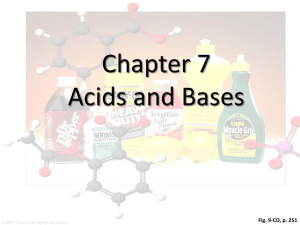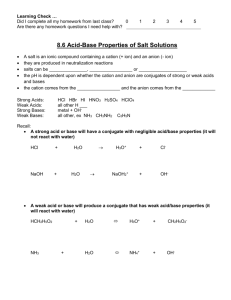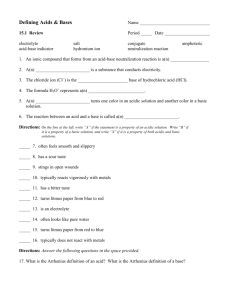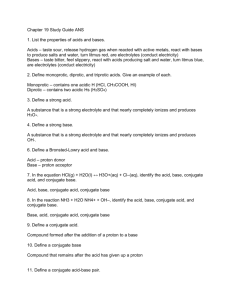Acids and Bases - Seattle Central College
advertisement
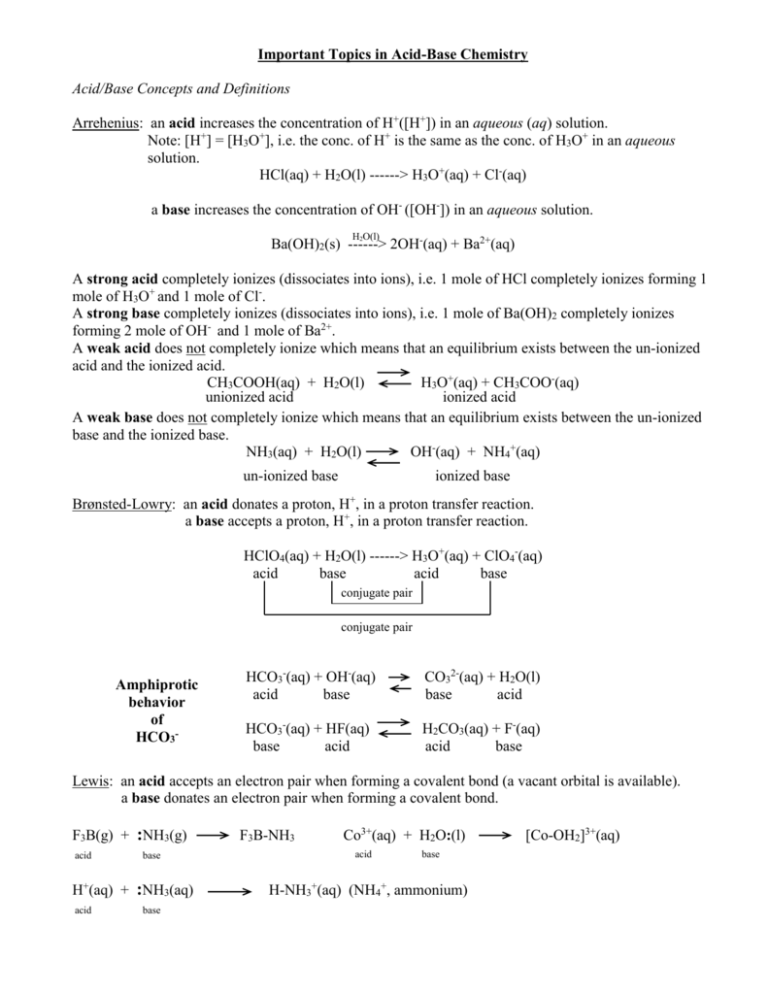
Important Topics in Acid-Base Chemistry
Acid/Base Concepts and Definitions
Arrehenius: an acid increases the concentration of H+([H+]) in an aqueous (aq) solution.
Note: [H+] = [H3O+], i.e. the conc. of H+ is the same as the conc. of H3O+ in an aqueous
solution.
HCl(aq) + H2O(l) ------> H3O+(aq) + Cl-(aq)
a base increases the concentration of OH- ([OH-]) in an aqueous solution.
H2O(l)
Ba(OH)2(s) ------> 2OH-(aq) + Ba2+(aq)
A strong acid completely ionizes (dissociates into ions), i.e. 1 mole of HCl completely ionizes forming 1
mole of H3O+ and 1 mole of Cl-.
A strong base completely ionizes (dissociates into ions), i.e. 1 mole of Ba(OH)2 completely ionizes
forming 2 mole of OH- and 1 mole of Ba2+.
A weak acid does not completely ionize which means that an equilibrium exists between the un-ionized
acid and the ionized acid.
CH3COOH(aq) + H2O(l)
H3O+(aq) + CH3COO-(aq)
unionized acid
ionized acid
A weak base does not completely ionize which means that an equilibrium exists between the un-ionized
base and the ionized base.
NH3(aq) + H2O(l)
OH-(aq) + NH4+(aq)
un-ionized base
ionized base
Brønsted-Lowry: an acid donates a proton, H+, in a proton transfer reaction.
a base accepts a proton, H+, in a proton transfer reaction.
HClO4(aq) + H2O(l) ------> H3O+(aq) + ClO4-(aq)
acid
base
acid
base
conjugate pair
conjugate pair
Amphiprotic
behavior
of
HCO3-
HCO3-(aq) + OH-(aq)
acid
base
CO32-(aq) + H2O(l)
base
acid
HCO3-(aq) + HF(aq)
base
acid
H2CO3(aq) + F-(aq)
acid
base
Lewis: an acid accepts an electron pair when forming a covalent bond (a vacant orbital is available).
a base donates an electron pair when forming a covalent bond.
F3B(g) + :NH3(g)
acid
base
H+(aq) + :NH3(aq)
acid
base
F3B-NH3
Co3+(aq) + H2O:(l)
acid
base
H-NH3+(aq) (NH4+, ammonium)
[Co-OH2]3+(aq)
How does one determine the favored direction of a Brønsted-Lowry acid-base reaction?
1) Identify the acid-base conjugate pairs.
2) Identify the weakest conjugate base of each pair. Use Figures 14.5 & Table 14.2 in Zumdahl.
Weakest means Most Stable
3) Choose the direction that forms the weakest conjugate base.
CH3OH(aq) + CH3COO-(aq)
1) A1
CH3COOH(aq) + CH3O-(aq)
B2
A2
B1
2) B2 is weaker than B1 according to Table 17.1
3) The favored direction is toward reactants, A1 and B2
CH3OH(aq) + CH3COO-(aq)
CH3COOH(aq) + CH3O-(aq)
Ionization Equilibria for Weak Acids and Bases
1
Acid: H2S(aq) + H2O(l)
Base: NH3(aq) + H2O(l)
-
+
HS (aq) + H3O (aq)
NH4+(aq) + OH-(aq)
-
+
Kc = [HS ][H3O ]/[H2S][H2O]
Ka = [HS-][H3O+]/[H2S]
Kc = [NH4+][OH-]/[NH3][H2O]
Kb = [NH4+][OH-]/[NH3]
1
See Table 17.3, page 678 for Ka and Kb values for a number of weak acids and bases.
Degree of Ionization (x 100 = Percent Ionization): The fraction of molecules (weak acid or base) that
react with water to give ions. If acid HA has a degree of ionization of 0.10 (10.%) then for every 10 HA
molecules, only 1 molecule ionizes in water to H3O+ and A-. Percent Ionization increases as a solution of
a weak acid or base is diluted. Why?
Polyprotic Acids
"many protons":
H2CO3(aq) + H2O(l)
HCO3-(aq) + H3O+(aq) Ka1 = 4.3 x 10-7
HCO3-(aq) + H2O(l)
CO32-(aq) + H3O+(aq) Ka2 = 4.8 x 10-11
Ka2 < Ka1 Generally, subsequent ionizations are less favored. Why?
Autoionization of Water, An Equilibrium
H2O(l) + H2O(l)
H3O+(aq) + OH-(aq)
Note the magnitude of Kw, what does it mean?
1
Kc = [H3O+][ OH-]/[ H2O]2
Kw = [H3O+][ OH-]
Kw = [H3O+][ OH-] = 1.0 x 10-14 at 25 ºC, pure water
In pure water, [H3O+] = [ OH-] = 1.0 x 10-7
A solution is acidic if [H3O+] > 1.0 x 10-7, neutral if [H3O+] = 1.0 x 10-7, and basic if [H3O+] < 1.0 x 10-7
pH: “potential of hydrogen ion” (Apparently devised by a Dane named Sørensen while brewing beer)
pH = -log[H+] Note, we are considering the pH of only aqueous solutions, so [H+] = [H3O+]. Remember
too that [H+] really means the activity of H+ ([H+]/{1 M}) which is unitless, thus pH is unitless.
An aqueous solution has [H+] = 2.56 x 10-4 M, pH = -log(2.56 x 10-4) = 3.592
The number of significant digits in the concentration = the number of decimal places in the mantissa
(3 = characteristic, .592 = mantissa)
pH in aqueous solution ranges from 0-14.
pH + pOH = 14.00
A solution is acidic if pH < 7, neutral if pH = 7, and basic if pH > 7
Problem Solving Techniques: See Section 14.12
Acid-Base Properties of Salt Solutions
Salts may be obtained by neutralizing an acid with a base in aqueous solution. Given this neutralization
the aqueous salt solution that is produced is generally considered neutral in terms of pH. However, this is
only true when a strong acid is neutralized with a strong base (HCl + NaOH = NaCl + H2O).
Consider an aqueous solution of NaCN: NaCN(s)
Na+(aq) + CN-(aq)
The pH of a 0.1 M solution of NaCN has a pH = 11.1. How can this solution be basic?
The cyanide ion, CN-, unlike Na+, reacts with water: CN-(aq) + H2O(l)
HCN(aq) + OH-(aq)
Notice what happens here, the cyanide ion accepts a proton from water to form its conjugate acid, HCN,
and hydroxide, the strongest base that exists in water. It is this prescence of hydroxide that makes the salt
solution basic.
The term for an ion that reacts with water to generate the conjugate acid and hydroxide (see example
above) or the conjugate base and hydronium (see example below) is hydrolysis.
Consider an aqueous solution of NH4Cl:
NH4+(aq) + H2O(l)
NH4Cl(s)
NH4+(aq) + Cl-(aq)
NH3(aq) + H3O+(aq) This hydrolysis makes the salt solution acidic.
General Rules
If a salt can be made from a strong acid and strong base, no hydrolysis occurs in the salt solution-neutral.
If a salt can be made from a strong acid and weak base, hydrolysis occurs to give an acidic salt solution.
If a salt can be made from a weak acid and strong base, hydrolysis occurs to give a basic salt solution.
If a salt can be made from a weak acid and weak base, both ions of the salt hydrolyze. The salt solution is
acidic if Ka of the cation is greater than Kb of the anion.
Clever Relationships
Ka (acid) x Kb (its conjugate base) = Kw
[HS-][H3O+]/[H2S] x [H2S][OH-]/[HS-] = [H3O+][OH-]
Kb (base) x Ka (its conjugate acid) = Kw
[HCN][OH-]/[CN-] x [CN-][H3O+]/[HCN] = [OH-][H3O+]
Trends in Acidity, Basicity, and Stability
Ordered from least acidic to most acidic: HF < HCl < HBr < HI
Why?
The most acidic acid will have the most stable (weakest) conjugate base
Ordered from least stable to most stable: F- < Cl- < Br- < IWhy?
Charged species are unstable relative to uncharged species. Giving a neutral species a charge requires
energy to be added. The species that can distribute the charge within the largest volume is most stable.
I- has the largest volume, hence it is most stable and its conjugate acid, HI, is most acidic.
The trend here is that as you go down a column of elements their binary acids, HA, increase in acidity.
It should also be noted that the H-A bond decreases in strength in going down a column of elements.
Can you explain the following acidity trend CH4 < NH3 < H2O < HF? Realize that you are going across a
row of elements making up HA?
Strengths of oxoacids: HOCl > HOBr. Why? Consider the relative stabilities of the conjugate bases.
H2SO4 is a stronger acid than H2SO3 (Ka1: 103 > 1.3 x 10-2). Why is this? Your text talks about a greater
electron withdrawing ability for H2SO4 as a reason behind its relative acid strength. Well that’s true
enough, but think about the effect of the oxidation state of the sulfur in combination with this reason.
The effect of resonance for the stabilization of an acid’s conjugate base-acetic acid vs. methanol.
The effect of induction for the stabilization of an acid’s conjugate base-chloroacetic acid vs. acetic acid.





